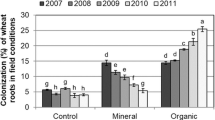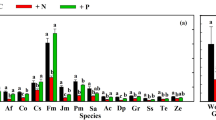Abstract
The dynamics of mycorrhizae under disturbance created by crop production is not well understood. A 3-year experiment was undertaken on a nutrient-poor and acidic land that had last been cultivated in the early 1970s. We observed the effects of cropping spring barley (Hordeum vulgare L.) under four P-fertilizer levels and four levels of lime, in a minimum (rototillage), a reduced (chisel), or a conventional tillage system, on the mycorrhizal receptiveness of the host (maximum level of mycorrhizal colonization, as measured at harvest) and soil infectivity most probable number method. The host receptiveness decreased with time, while crop yields and soil infectivity increased simultaneously with time. Liming increased mycorrhizal colonization of barley roots and soil infectivity. P additions decreased root colonization but did not significantly affect the most probable number valuse. Slightly higher soil infectivity estimates were found under reduced tillage.
Similar content being viewed by others
References
Anderson EL, Millner PD, Kunishi HM (1987) Maize root length density and mycorrhizal infection as influenced by tillage and soil phosphorus. J Plant Nutr 10:1349–1356
Brundrett MC, Piché Y, Peterson RL (1984) A new method for observing the morphology of vesicular-arbuscular mycorrhizae. Can J Bot 62:2128–2134
Danielson RM, Visser S (1989) Effects of forest soil acidification on ectomycorrhizal and vesicular-arbuscular mycorrhizal development. New Phytol 112:41–47
Dodd JC, Arias I, Koomen I, Hayman DS (1990) The management of populations of vesicular-arbuscular mycorrhizal fungi in acid-infertile soils of a savanna ecosystem. I. The effect of precropping and inoculation with VAM-fungi on plant growth and nutrition in the field. Plant and Soil 122:229–240
Douds DD Jr (1994) Relationship between hyphal and arbuscular colonization and sporulation in a mycorrhizal of Paspalum notatum Flugge. New Phytol 126:233–237
Douds DD Jr, Schenck NC (1990) Increased sporulation of vesicular-arbuscular mycorrhizal fungi by manipulation of nutrient regimens. Appl Environ Microbiol 56:413–418
Fisher RA, Yates F (1963) Statistical tables for biological, agrienltural and medical research, 6th edn. Hafher Publishing, New York
Follett RH, Murphy DS, Donahue RL (1981) Fertilizers and soil amendments. Prentice-Hall, Englewood Cliffs, NJ
Giovanetti M, Mosse B (1980) An evaluation of techniques for measuring vesicular-arbuscular infection of roots. New Phytol 84:489–500
Hamel C, Dalpé Y, Lapierre C, Simard RR, Smith DL (1994) Composition of the vesicular-arbuscular mycorrhizal fungi population in an old meadow as affected by pH, phosphorus and soil disturbance. Agric Ecosyst Environ 49:223–231
Harinikumar KM, Bagyaraj DJ (1988) Effect of crop rotation on native vesicular arbuscular mycorrhizal propagules in soil. Plant and Soil 110:77–80
Hayman DS, Tavares L (1985) Plant growth responses to vesicular arbuscular mycorrhiza. XV. Influence of soil pH on the symbiotic efficiency of different endophytes. New Phytol 100:367–377
Jensen A, Jakobsen I (1980) The occurrence of vesicular arbuscular mycorrhiza in barley and wheat grown in some danish soils with different fertilizer treatments. Plant and Soil 55:403–414
Johnson NC, Pfleger FL (1992) VA mycorrhizae and cultural stresses. In: Bethlenfalvay GJ, Linderman RG (eds). Mycorrhizae in sustainable agriculture. Spec Publ, Soc Agron, Madison, Wis, pp 71–99
Klironomos JN, Kendrick B (1993) Research on mycorrhizas: Trends in the past 40 years as expressed in the “Mycolit” data base. New Phytol 125:595–600
Kucey RMN, Diap GES (1984) Effects of lime, phosphorus and addition of vesicular-arbuscular (VA) mycorrhizal fungi on indigenous VA fungi and on growth of alfalfa in a moderately acidic soil. New Phytol 98:481–486
Lapierre C (1991) Effect des pratiques culturales réduites sur l'efficacité de la chaux et du phosphore dans les sols agricules du Québec. Rapport final, projet 3 B 1-32180260-007, Entende auxiliaire Canada-Québec sur le développement agroalimentaire, Recherche en conservation du sol et de l'eau, Agriculture Canada, Québec
Lebart L, Morineau A, Warwick KM (1984) Multivariate description statistical analysis. Correspondence analysis and related techniques for large matrices. Wiley and Sons, New York Chichester Brisbane Toronto Singapore
Mamo T, Killham KS (1987) Effect of soil liming and vesicular arbuscular-mycorrhizal inoculation on the growth and micronutrient content of the teff plant. Plant and Soil 102:257–259
Medina OA, Sylvia DM, Kretschmer AE (1988) Response of siratro to vesicular-arbuscular mycorrhizal fungi: I. Selection of effective vesicular-arbuscular fungi in amended soil. Soil Sci Am J 52:416–419
Mehlich A (1984) Mehlich 3 soil test extractant. A modification of Mehlich 2 extractant. Commun Soil Sci Plant Anal 15:1409–1416
Neter J, Wasserman W, Kutner MH (1985) Applied linear statistical models regression, analysis of variance, and experimental designs, 2nd edn. Irwin Homewood, Illinois
Porter WM (1979) The “most probable number” method for enumerating infective propagules of VAM fungi is soil. Aust J Soil Res 17:515–519
Ray AA (1982) SAS user's guide: Basics. SAS Institute, Cary, NC
Sieverding E (1991) Vesicular-arbuscular mycorrhiza management in tropical agroecosystems. Deutsche Gesellschaft für Technische Zusammenarbeit (GTZ) GmbH, Eschborn
Smith TF (1978) A note on the effect of soil tillage on the frequency and vertical distribution of spores of vesicular-arbuscular endophytes. Aust J Soil Res 16:359–361
Steel RGD, Torrie JH (1980) Principles and procedures of statistics: biometrical approach, 2nd edn. McGraw-Hill, New York Bogota London Madrid Mexico New Delhi
Thomas RL, Sheard RW, Moyer JR (1968) Comparison of conventional and automated procedures for nitrogen, phosphorus and potassium analysis of plant material using a single digestion. Agron J 59:240–243
Tobar RM, Azcón R, Barea JM (1994) The improvement of plant N acquisition from an ammonium-treated, drought-stressed soil by the fungal symbiont in arbuscular mycorrhizae. Mycorrhiza 4:105–108
Author information
Authors and Affiliations
Rights and permissions
About this article
Cite this article
Hamel, C., Dalpé, Y., Lapierre, C. et al. Endomycorrhizae in a newly cultivated acidic meadow: Effects of three years of barley cropping, tillage, lime, and phosphorus on root colonization and soil infectivity. Biol Fertil Soils 21, 160–165 (1996). https://doi.org/10.1007/BF00335928
Received:
Issue Date:
DOI: https://doi.org/10.1007/BF00335928




